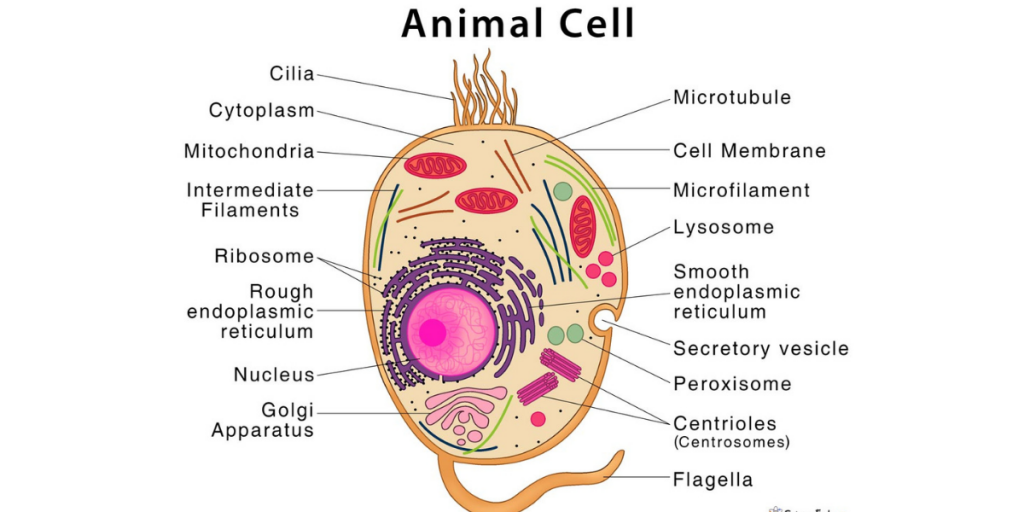A cell in all its state, the smallest unit that can live on its own. When millions of cells come together, it forms tissues and organs. So, in short, the cell is the fundamental foundation of any living thing, whether it’s human, animal, or plant.
A cell has three important parts: the cell membrane, the nucleus, and the cytoplasm. A cell tends to be 1-100 micrometers in diameter. Each cell has its function. Yet, they all carry the basic function of life.
When cells work together, they form tissues. Which then form organs. In this article, we will discuss the cell found in animals and the different parts it has. That is the animal cell. But first, let us know what is Animal Cell is.
What is Animal Cell?
An animal cell is a cell that is present in any organism that comes from the kingdom Animalia. Depending upon the type of cell, it comes in different shapes and sizes. And also they carry out different functions.
An animal cell is different from the cells that are present in plants or fungi. Cells are of two different categories like eukaryotic and prokaryotic. Animal and plant cells are from the eukaryotic category.
The different animal cell has different components. Some might have certain components which others lack. Yet, we are going to list down the different parts and components of an animal cell.
Different Parts of An Animal Cell

There are 12 main and important components or parts of the cell present in almost every cell in an animal. They are as follows:
The Cell Membrane
The outer edge of the cell is what we call the cell membrane. Cell Membrane forms the boundary between the inside and the extracellular matrix.
Different types of macromolecules are present inside the cell membrane. These macromolecules are glycoproteins. Glycoproteins help instability. It also channels proteins so that some materials can move in and out of the cell.
The Nucleus
The nucleus is the heart of the cell. It contains the DNA of the cell. Since it is the most important component of the cell, it directs whatever happens in the cell.
The nucleus is the component that does the major and primary functions of the cell.
The Nuclear Membrane
The nucleus membrane is to the nucleus is what cell membrane is to the cell. The nuclear membrane defines the outline of the nucleus.
Cytoplasm and Cytosol
Cytosol is a gel-like fluid that fills up the space in the cell. It is quite thick fluid. This is where the organelles are present in the suspension state. Everything except the nucleus, rest is cytoplasm. That means that the cytoplasm includes the Cytosol and the organelles.
Ribosomes
Ribosomes are nothing but organelles. Ribonucleic Acids and proteins form ribosomes. Ribosomes are either found attached to the endoplasmic reticulum. Or it is there suspended in the Cytosol. Ribosomes are the component that improves protein synthesis.
The Golgi Apparatus
The Golgi apparatus is a component that forms from cisternae. And it is not interconnected. The main thing the Golgi Apparatus dies is to move molecules that are produced in the cell outside of the cell.
Endoplasmic Reticulum
The endoplasmic reticulum is a component that forms from cisternae. And it connects to the nuclear membrane. There are two types of Endoplasmic Reticulum – one is rough, and the other one is smooth. The rough one has the ribosome attached to its surface. At the same time, the smooth does not have the ribosome attached to its surface.
Mitochondria
Mitochondria are amongst the large organelles. Mitochondria has an inner as well as an outer membrane. It also has its very own Mitochondrial DNA inside it. Mitochondria is where the oxygen and glucose are transformed into ATP. ATP is then used as energy by the cell.
Cytoskeleton
The Cytoskeleton is what given the strength and the shape of a cell. The Cytoskeleton also transports elements within the cell. The Cytoskeleton can maintain its shape because of the network of filaments that it has.
Centrioles
To maintain the cell division at the time of mitosis, centrioles helps. These are a bunch of microtubules that help in cell division.
Vacuoles
Vacuoles have a single membrane layer that has gas or fluid. It is in the form of small pockets. It contains a gas such as carbon dioxide to oxygen.
Vesicles
Vesicles sound like vacuoles but have a slight difference. Vesicles are mostly included in the process of metabolism.
Final Thoughts
So these were the parts of the cell that is also known as the animal cells. There might be certain animal cells that will not have all the components in the list above. Yet, it is a broad spectrum of what components are there in the animal cell.
Hope this article is informative for you.

